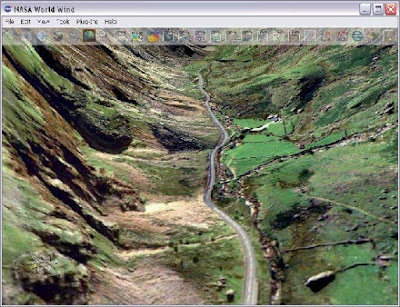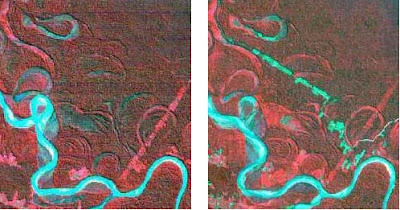IMAGE INTERPRETATION
What is Image Interpretation?
“The examination of images for the purpose of identifying objects and judging their significance.” By Philipson, 1997.The data (image) generated by Remote Sensing Sensors have to be interpreted / analyzed to generate meaningful information by using;
•Experience
•Structured
Photo / Image Interpretation is used as a Powerful Scientific Tool such as;
- The Aerial / Regional perspective
- Three-dimensional depth perception
- Knowledge beyond our human visual perception
- Historical records for proof
The Aerial / Regional perspective:
- For Military Reconnaissance
- For Peaceful Earth Resource Scientific Investigation
Precautions
- Interpreting Vertical Imagery
- Interpreting Oblique Imagery
Human line of sight on the ground is usually less than a kilometer.
Three Dimensional Depth Perception
- Aerial Photographs
- Images (Satellite Sensors)
The Stereoscopic analysis process usually exaggerates the height or depth of the terrain, allowing us to appreciate very subtle differences in object height and terrain slope and aspect that we might never appreciate from a terrestrial vantage point.
Obtaining Knowledge Beyond our Human Visual Perception
Measure the activity of X-rays, Ultraviolet, Near-infrared, Middle-infrared, Thermal-infrared, Microwave, Radio-wave Energy.
Thermal Imagery
Laser Imagery
Historical records for proof
Basic Principles
A) Images and Their Interpretability:
Images can be interpreted by following patterns;
- A pictorial presentation of the pattern of a Landscape.
- Pattern is composed of indicators of objects and events that relate to the physical, biological and cultural components of the landscape.
- Type of amount extracted is proportional to the knowledge, skill and experience of the analyst, the methods used for interpretation and the analyst’s awareness.
B) Sequence of Activities:
- Detection selectively picking out an object or element of importance for the particular kind of interpretation in hand.
- Recognition and Identification by means of specific or local knowledge.
- Analysis process of separating or delineating a set of similar objects.
- Deduction directed to the separation of different groups of objects or elements and the deduction of their significance based on converging evidence
- Classification establishes the identity of a surface or an object delineated by analysis
- Idealization refers to the process of drawing or standardized representations of what is actually seen.
C) Methods of Search and Sequence of Interpretation:
- Fishing expedition an examination of each and every object so as not to miss anything.
- Logical Search quick scanning and selective intensive study.
D) Elements of Image Interpretation: (By Olson, 1960)
- Primary Elements: Tone, Color
- Secondary Elements: Size, Shape, Texture
- Tertiary Elements: Pattern, Height, Shadow
- Higher Elements: Site, Association
E) Interpretation Keys:
Scope of Image Interpretation Keys:
- An Item Key concerned with the identification of an individual object or condition.
- A Subject Key a collection of item keys concerned with the identification of principal objects or conditions within a given subject category.
- A Regional Key a compilation of items or subject keys dealing with the identification of objects or conditions characteristics of a particular region.
- An Analogous Area Key a subject or regional key which has been prepared for an accessible area and which by interpretation may be used in the interpretation of objects or conditions in inaccessible areas which exhibit similar characteristics.
Technical Level Image Interpretation Keys:
- A Technical Key one prepared for use by image interpreters who have had professional or technical training or experience in the subject concerned.
- A Non-Technical Key one prepared for use primarily by image interpreters who have not had professional or technical training or experience in the subject concerned.
Intrinsic Character of Image Interpretation Keys:
- A Direct Key is a designed primarily for the identification of discrete objects or conditions directly discernible on image.
- An Association Key is one designed primarily for the deduction of information not directly discernible on images.
Manner of Organization or presentation of Image Interpretation Keys:
a) Selective Keys:
- An Essay Key is one where objects or conditions are described in textural form using images for illustrations only.
- A File Key is an item key composed of one or more selected images, with notes concerning their interpretation –Individual Interpreter.
- A Photo Key is an item key composed of one or more selected images, together with notes concerning their interpretation, assembled for rapid reproduction and distribution to other interpreters.
- An Integrated-selective Key is one which images are recognition features for any individual object or condition. Within a subject or regional key, are so associated that by reference to the appropriate portion of the key the object or condition can be identified.
b) Elimination Keys:
- A Disk key selected images recognition features are grouped or arranged on one or more disks so that, when the recognition features are properly aligned, all but one object or condition of the group under consideration is eliminated from view
- A Punch Card Key one in which selected image recognition features are arranged in groups on separate punch cards, When the properly selected cards are superimposed upon a coded base, all but one object or condition of the subject group under consideration is eliminated from view
- A Dichotomous Key is one in which the graphic or word description assumes the form of a series of pairs of contrasting characteristics which permit progressive elimination of all but one object or condition of the subject group under consideration















Post a Comment